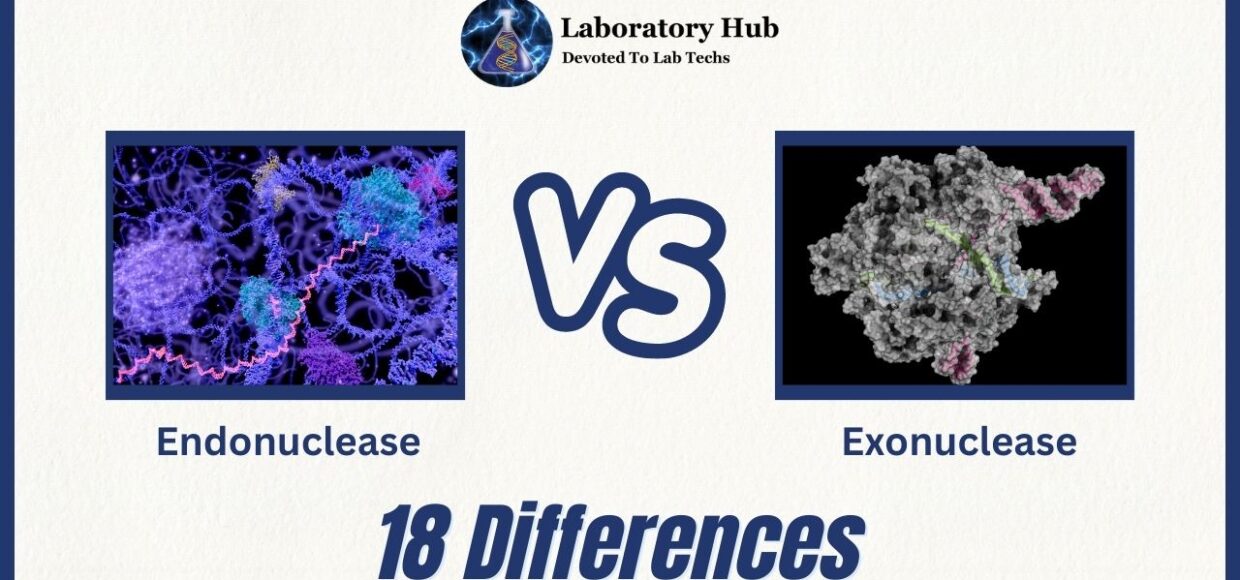18 Differences between Endonuclease vs Exonuclease
Understanding DNA replication, repair, and recombination is essential in molecular biology. These procedures need endonucleases and exonucleases. Endonucleases and exonucleases are essential to DNA metabolism, although their processes, functions, and sites differ. This study will explore endonucleases and exonucleases and their distinctive roles in cellular activities.
Endonucleases break DNA phosphodiester links. Endonucleases cut DNA at internal locations, unlike exonucleases, which remove nucleotides from DNA ends. Endonucleases are necessary for DNA repair, replication, and recombination due to their specificity. Endonucleases also recognize and remove damaged DNA segments and generate DNA fragments during DNA fragmentation.
However, exonucleases remove nucleotides from DNA or RNA molecules one by one. 5′ or 3′ exonucleases can function in either way. Exonucleases proofread DNA replication, remove mismatched or broken nucleotides, and maintain DNA integrity. RNA processing and degradation also regulate gene expression.
Endonucleases and exonucleases work differently but have some similarities. Genomic stability and DNA replication need both enzymes. Both groups of enzymes are present in bacteria through humans, demonstrating their evolutionary importance.
Understanding endonucleases and exonucleases has far-reaching effects. These enzymes have enabled technological breakthroughs like DNA sequencing and CRISPR-Cas9. These enzymes can also cause genomic instability, cancer, and genetic diseases.
Endonucleases and exonucleases are essential to DNA metabolism, each having their own functions. These enzyme pathways can illuminate complex biological processes and reveal new treatment targets. As we explore molecular biology, endonucleases and exonucleases will change our knowledge of life’s building components.
S. No. | Aspect | Endonucleases | Exonucleases |
1 | Definition | Enzymes that cleave DNA/RNA within a strand | Enzymes that cleave DNA/RNA from the ends |
2 | Cleavage Site | Cleave at specific internal sites on the nucleic acid strand | Cleave at the ends of the nucleic acid strand |
3 | Function | Involved in DNA repair, recombination, and restriction digestion | Involved in DNA repair, degradation, and processing |
4 | Mode of Action | Cleave the phosphodiester bond within the DNA/RNA strand | Remove nucleotides one at a time from the end |
5 | Directionality | Cleave nucleic acids in a random direction | Cleave nucleic acids in a specific direction |
6 | Activity | Single-stranded or double-stranded DNA/RNA can be targeted | Single-stranded or double-stranded DNA/RNA can be targeted |
7 | Examples | EcoRI, BamHI (restriction endonucleases) | Exonuclease I, Exonuclease III (DNA exonucleases) |
8 | DNA Repair | Involved in DNA damage repair mechanisms | Involved in DNA repair processes |
9 | Repair Pathways | Participate in base excision repair, nucleotide excision repair, and mismatch repair pathways | Participate in DNA repair pathways |
10 | DNA Modification | Can induce DNA breaks and modification at specific sites | Do not induce DNA breaks or modification |
11 | Sequence Specificity | Recognize specific DNA/RNA sequences for cleavage | Not sequence-specific for cleavage |
12 | Processivity | Can cleave multiple sites within a DNA/RNA molecule | Cleave nucleotides one at a time |
13 | Biological Role | Involved in various cellular processes related to DNA metabolism | Involved in DNA replication and repair processes |
14 | Nucleotide Removal | Do not remove nucleotides from the end of the nucleic acid | Remove nucleotides from the end of the nucleic acid |
15 | Catalytic Mechanism | Utilize different mechanisms to cleave phosphodiester bonds | Utilize different mechanisms for nucleotide removal |
16 | Repair Efficiency | Can efficiently repair DNA damage at specific sites | Participate in the degradation of damaged DNA |
17 | Role in Recombination | Participate in DNA recombination processes | Not directly involved in DNA recombination |
18 | Enzyme Structure | Various types of endonucleases with different structural motifs | Various types of exonucleases with different structural motifs |
Also Read: Light Microscope vs Electron Microscope – 40 Major Differences
Frequently Asked Questions (FAQs)
Endonucleases break phosphodiester links at interior DNA locations.
Exonucleases remove nucleotides from DNA or RNA ends one by one.
Bacteria to humans have endonucleases and exonucleases.
These enzymes enabled precision DNA sequencing and gene editing tools like CRISPR-Cas9.
Endonucleases extract damaged DNA, whereas exonucleases remove mismatched or damaged nucleotides during DNA repair.
Enzyme dysregulation or mutations can cause genomic instability, cancer, and genetic diseases.
Endonucleases cut DNA at certain internal locations, while exonucleases can function in either way.
Endonucleases generate DNA fragments during DNA fragmentation, which aids DNA replication.
Exonucleases degrade RNA molecules, regulating gene expression.
Both enzymes preserve genomic stability by replicating DNA accurately, mending damaged DNA, and correcting DNA or RNA mistakes.







